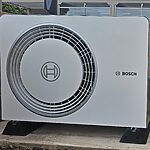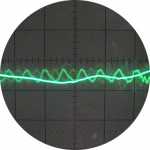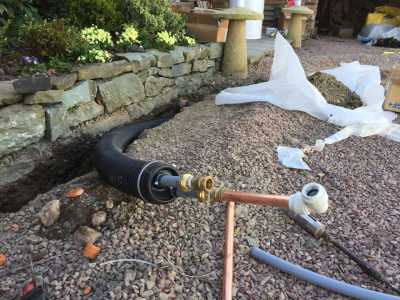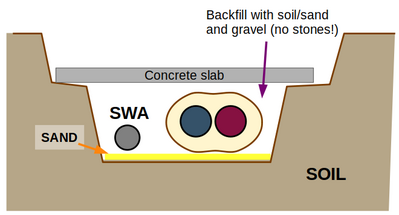Surface mount or bury primaries for heat pump installation?
Hi,
I'm in the early stages of planning my heat pump installation and whilst I know where the pump itself will be sited, I need to work out how to get the water into the garage. The path will see the pipes run up the side access and turn into the garage before getting connected to my heating. The route includes data and power cable.
I have two options.
1. I surface mount the primaries and run them along my neighbour's wall. I then have to either go under the paving or run the pipes up an over. I'll need a bracket of some sort between my neighbour's wall and the heat pump itself as I can't fix them to their failing timber fence.
2. I bury an instulated pipe that holds everything. The problem is that my side access is pretty busy underground with storm, waster and water main pipes. I'm told I should bury the pipe at 600mm, but I don't believe that's possible. At least not all the way. I have photos of this before it was backfilled.
What I want to know is why we can surface mount pipes in insulation, but we're required to put insulated pipes quite deep in the ground.
Has anyone got their primaries buried at a depth less than 600?
Owner of a ridiculously oversized 35kW boiler and trying to make it as efficient as possible. 4.8kW solar PV with 5.4kWh storage. EV driver.
Follow my journey at https://www.youtube.com/@tomasmcguinness
Next big project is a heat pump!
I think I would be wary of attaching my services to a neighbours property without some form of legal agreement to allow this and the required access to them in perpetuity. It also leaves the pipework at the risk of the neighbouring owner, or any future owner, making perfectly legal changes to their property which impacts on your pipe run.
@abernyte That is an excellent point. I hadn't considered that at all! I think I'll be burying a pipe 🙂
Owner of a ridiculously oversized 35kW boiler and trying to make it as efficient as possible. 4.8kW solar PV with 5.4kWh storage. EV driver.
Follow my journey at https://www.youtube.com/@tomasmcguinness
Next big project is a heat pump!
Posted by: @tomasmcguinnessHas anyone got their primaries buried at a depth less than 600?
Yes, ours are buried. 20m run from the heat pump to the utility room. Buried at roughly 50-60cm. I dug the trench myself with pickaxe and spade, because I knew there pipes (waste and gutter run off) underground.
The insulated heat loss pipe is quite pricey from what I can remember.
Get a copy of The Ultimate Guide to Heat Pumps
Subscribe and follow our YouTube channel!
@editor My side access already contains services, so it's not easy. I think I'm going to have to shallow bury the pipe as it will need to go over some of the existing services. There is clay pipe down there and I don't want to disturb that.
Is there any solid guidance on buying pipes? I'm less concerned about the water and more about the electrical cable.
Owner of a ridiculously oversized 35kW boiler and trying to make it as efficient as possible. 4.8kW solar PV with 5.4kWh storage. EV driver.
Follow my journey at https://www.youtube.com/@tomasmcguinness
Next big project is a heat pump!
Broadly, the electrical cable will need to be either earthed armoured or in a duct to prevent mechanical damage. Both need to be marked with the required tape.
@tomasmcguinness, because ours runs under our driveway, and I was keen to avoid going too shallow in case it ever got damaged from heavy vehicle deliveries or future resurfacing.
As for guidance on insulation depth, the general 600mm recommendation is more about frost protection and physical damage prevention than some hard and fast requirement (as far as I know anyway). If you’re using decent insulated pipework and you’re not in an area prone to severe frost, going a bit shallower (like 300–400mm) in tight spots should be fine.
In your case, I’d agree that shallow burial with good-quality pre-insulated pipework is a practical way forward. You could always add some additional foam lagging and a protective duct over the section that runs shallower, just to give it a bit of extra mechanical protection.
On the electrical side, the key thing is to use appropriately rated armoured cable, preferably in its own duct separate from the primary pipe, especially if it’s running alongside heat-carrying pipework. It’s also worth checking the manufacturer’s guidance… some kits include pre-bundled solutions, while others require cables to be run independently.
Out of interest, which heat pump are you going with? And who’s installing it? Always helpful context for others following your project too.
Get a copy of The Ultimate Guide to Heat Pumps
Subscribe and follow our YouTube channel!
@abernyte I was thinking of an SWA *in* the ducting. I'm looking at a combined water and electrical pipe (uponor or isoflow for example).
Owner of a ridiculously oversized 35kW boiler and trying to make it as efficient as possible. 4.8kW solar PV with 5.4kWh storage. EV driver.
Follow my journey at https://www.youtube.com/@tomasmcguinness
Next big project is a heat pump!
Current thinking is a Kronoterm Adapt. Doing the ground works myself (trench digging, base casting, that sort of thing). Then the professionals will finish the job.
Presently, I'm just exploring my options to get the water from the heat pump into the garage.
I'm constrained by the existing services, so I'm not sure how deep I'll actually manage.
Owner of a ridiculously oversized 35kW boiler and trying to make it as efficient as possible. 4.8kW solar PV with 5.4kWh storage. EV driver.
Follow my journey at https://www.youtube.com/@tomasmcguinness
Next big project is a heat pump!
@tomasmcguinness bold choice on the Kronoterm. Nice! Will be very curious to see how it performs. Have heard very good things about them.
Get a copy of The Ultimate Guide to Heat Pumps
Subscribe and follow our YouTube channel!
@tomasmcguinness HI, The rules is a best practise, the heating pipes do not come under the same rules as services such as gas and mains drinking water.
Mostly its for frost protection but when the pipes are only just below the surface it is advisable to well insulate above 100mm thickness to slow losses and mechanically protect if possible.
AAC Group Ltd covering the Kent Area for design, supply and installation of ASHP systems, service and maintenance, diagnostics and repairs.
Professional installer. Book a one-to-one consultation for pre- and post-installation advice, troubleshooting and system optimisation.
Posted by: @tomasmcguinnessI was thinking of an SWA *in* the ducting.
What you run the cable through will affect its current rating (and hence voltage drop).
SWA is intended for direct burial in the ground... the wetter the better.
You want any heat-loss from the cable to be conducted away into the surrounding soil.
Placing a cable inside an air-filled duct has the opposite effect.
The air acts as an insulating jacket. You've just made yourself an underground oven in a long tube. 😥
When you select the required cable size, you would usually enter the figures into an online calculator.
Here's one on the website for TLC-Direct.
That will tell you the cross-sectional area of the copper conductors you will require.
Secondly, if you have any services at shallow depth, where they might get hit by a garden fork for example,
place some basic paving slabs above them.
Although buried electrical cables must also have warning tape above them,
there's nothing like having the fork hit a 40mm piece of concrete slab to warn you there's something down there!
Save energy... recycle electrons!
-
Weather compensation- why you should use it
2 days ago
-
Where has Watson gone?
2 months ago
-
First time wall mounting an ASHP
2 months ago
-
How can I programme a setback for my Samsung Gen6 8kW heat pump?
2 months ago
-
Rodents! A word of warning for heat pump owners
3 months ago
- 26 Forums
- 2,391 Topics
- 54.2 K Posts
- 360 Online
- 6,074 Members
Join Us!
Worth Watching
Latest Posts
-
RE: Ecodan with FTC7 - True Weather Compensation
This is the part of your query that is currently puzzli...
By Sheriff Fatman , 7 seconds ago
-

RE: ASHP Energy Consumption: Aira 12kW heat pump
I was supposed to write/comment about this last year, b...
By Mars , 12 minutes ago
-

RE: Installer Fitted 9kW Instead of 11kW Heat Pump and Changed MCS Paperwork - What do I do?
@mairia, I'm staggered that NAPIT have not been in touc...
By Mars , 19 minutes ago
-
RE: Recommended home battery inverters + regulatory matters - help requested
Each inverter would be limited to 16A export. But they ...
By Batpred , 1 hour ago
-
RE: Advice for a novice on Mitsubishi Ecodan 6kW
Worth also adding that, assuming you know the rough ove...
By Sheriff Fatman , 2 hours ago
-
Daikin Atherma ASHP Cycling 6 Times an Hour?
I have a Daikin Atherma EDLQ07CAV unit and I've come he...
By John Marshall , 2 hours ago
-
RE: Octopus Cosy Heat Pump Owners & Discussion Thread
My Cosy6 heat output was 116kWh yesterday, giving an av...
By AgentGeorge , 3 hours ago
-

@majordennisbloodnok This is some really good stuff. I ...
By Steelbadger , 15 hours ago
-
RE: Gen 6 Samsung ASHP losing 20C of DHW in 60 min directly after generation
Shouldn’t your temp sensor be in the middle or lowest s...
By EcoBaker , 16 hours ago
-
RE: New Fogstar 15.5kWh upright solution
@batpred In all fairness you haven't provided any he...
By Bash , 16 hours ago
-
RE: Insulating a pitched roof with kingspan, has anyone done it?
Thank you everyone for all of the information, it looks...
By TRBob , 17 hours ago
-
RE: Solar Power Output – Let’s Compare Generation Figures
@transparent Yep, they didn’t even mention it. When ...
By Papahuhu , 18 hours ago
-
Air source heat pump circuit not operational
Hi - need some advice about one circuit on my heating s...
By Plummersknowe , 18 hours ago
-

RE: Setback savings - fact or fiction?
They are lovely, and I feel lucky to live in one, but t...
By cathodeRay , 19 hours ago
-
RE: Who's your electricity provider and what's your tariff?
Worth adding that, for this tariff, the Octopus app has...
By Batpred , 20 hours ago
-

RE: APP for remote Daikin ASHP Operation
Thanks, @newhouse87. Understood. I was only asking on...
By Majordennisbloodnok , 20 hours ago
-
@mike-patrick A propos, I think my heat pump generates ...
By dr_dongle , 20 hours ago
-

RE: Mitsu Zubadan flow temperature issue
Update: The flow temperature has now stabilized at 60C ...
By bontwoody , 21 hours ago
-
Balancing UFH flow rates, pump speeds etc
I have an old building with modern extension & ashp...
By Tim441 , 22 hours ago









